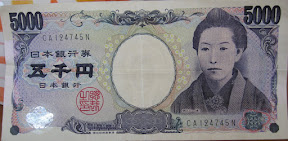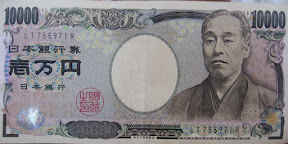So, now that I've been to Japan, and looked around for a bit, I'm an expert. Ok, not really. But during my two week visit I kept a notebook of the cultural things that seemed so foreign to me. Some of the things I read in the guide books I didn't believe until I experienced it. And some things were just bamboozling enough to my American-centric point of view that it was a fun mix of surprise and confusion.
Other than speaking and writing in Japanese, here's a short list of immediately obvious differences:
Cars drive on the left-hand side of the road
People also walk to the left side on sidewalks, stairs, escalators
A lot of the faucets turn counterclockwise to turn on.
All the locks turn counterclockwise to unlock.
Most school kids are in uniform, even for public schools
The money is different...

The first thing I didn't believe was that Japan is a cash-based society. I use my debit card and credit cards almost every day for purchases as small as a cup of coffee and a croissant. It's rare that I have more than $80 in my wallet. I pay all my bills online and use the Internet to pay for postage.
So, when I was talking to people about getting cash in Japan I couldn't believe that I'd have any problem heading to the nearest ATM and pulling out what I needed. Except then I started to try to book some hotels. Most of the hotels I booked through a website called the
Japan Hotel Network, so all those hotels accepted credit cards. But some cheaper hotels, and hotels off the tourist track asked that I pay in cash. A room for $120 a night for two nights works out to be about 24,000 yen! Just the number of zeros was enough to make my head spin, but it was also a bit unnerving to have to know you have that much money on your person and it's budgeted for a hotel 10 or 12 days into the future.
A short aside here: Most hotels in Japan charge per person. If we had four people in our party we'd be charged for 4 times the base price, such as $40, or $160. That made sense for the most part, except that if you were just a single person you'd have to pay more, such as $60 a night. Also, since "four" in Japanese sounds like the word for "death", four was generally an unlucky number. We stayed in an
onsen where the rooms were numbered 201, 202, 203, 205, 206..., and there wasn't any fourth floor. Since we had four in our party we sometimes ended up sleeping in a room for three, but charged for four. Or, staying in two doubles.

My initial plan was to carry enough Traveler's cheques (TCs) and cash for a week, and then to pull out some more money at an ATM at a post office. At the last minute I changed my mind and just carried USD and exchanged almost all of it at the office exchange at
Narita. For some reason the rate was better for TCs over cash. Since I can get TCs for free through my bank I might plan to carry TCs, but still exchange them all at Narita (In Europe I saw exchange booths all over the large cities, but in not so much in Japan). At the time we went the official exchange booth was buying USD at 105 yen, and USD/TC at 107 yen.
It ended up the exchange rate for TCs was better than anything. I used my
Visa card to pay for most of the hotels and even used my debit card (with a Visa logo) to pay for a T-shirt in Asakusa. For both the credit card and the debit card the banks added a 3% "Foreign Transaction Fee." This wasn't so bad - ended up about the same rate as Narita -- between 104 and 105 yen per dollar. But as I've already said, it was hard to find places that accepted credit cards. I went to a
Tully's coffee shop in Tokyo and they only accepted cash. Same for the McDonald's.
On the flip side, every place was ready to accept large denominations of bills. On the trains there would often be someone pushing a food cart with drinks, chips and candy. We bought a milky tea and some chips for 300 yen and paid with a 10000 yen bill ($100). She handed over the change without a problem and then moved down the aisle to take more 10,000 yen bills. In fact, I noticed multiple times men with wallets packed with 20 or 30 ten-thousand yen notes. Everyone seemed unconcerned about carrying large amounts of cash. And I never saw even the smallest street-side vendor hesitate to make change for big bills.

![Reblog this post [with Zemanta]](http://img.zemanta.com/reblog_e.png?x-id=65736c6e-a619-4585-b933-dee979d9218a)
![Reblog this post [with Zemanta]](http://img.zemanta.com/reblog_e.png?x-id=bae75f6f-8f50-4110-a08e-d2e9abfab12c)
![Reblog this post [with Zemanta]](http://img.zemanta.com/reblog_e.png?x-id=2cfffbc7-7d6f-4baf-b03a-1c00e0bbec74)
![Reblog this post [with Zemanta]](http://img.zemanta.com/reblog_e.png?x-id=7d5f5ec4-888a-459c-9a25-03ceedb55911)